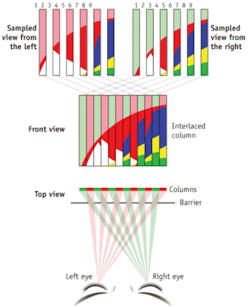BIOMEDICAL IMAGING: 3-D precision views without special glasses
“For a long time we were in doubt about whether autostereoscopic 3-D display technology can meet the high acceptance criteria for interactive visualization applications in life sciences,” said Dr. Luca Criscuolo, formerly Amira product manager with Visage Imaging. “Today we are convinced that the excellent 3-D visuals and depth cues provided by Tridelity´s multiview product line are a powerful tool to interactively explore multidimensional scientific data.”
Visage is using 3-D interactive displays by Tridelity Display Solutions (St. Georgen, Germany and Jersey City, NJ), to demonstrate Amira, its software platform for visualizing, manipulating, and understanding life-science and biomedical data. Tridelity also partnered recently with Carl Zeiss to enable better viewing of life-science microscopy images through AxioVision and Zen 2008 LE software. Tridelity’s 3-D displays are autostereoscopic–meaning they do not require viewers to wear special glasses or headgear. They allow viewers to see any type of content (animations, videos, still images, etc.) to be seen spatially in 3-D.
One or many viewers
Tridelity can set up its displays to serve either a single viewer or multiple viewers. The single-viewer system–a 3-D workstation designed for an individual user–generates two views of each frame of content, one each for the left and right eye. It enables higher-quality imaging than the multiviewer systems, but requires that the eyes of the user be positioned within the viewing “sweet spot”–approximately 70 cm in front of the display. An optional tracking system continually adjusts the sweet spot according to the viewer’s eye positions, without imposing any loss of image quality, says Tridelity CEO Norbert Haas.
By contrast, the multiviewer system projects five different perspectives in front of the screen. Because the five perspectives are horizontally spread, any number of viewers can see in 3-D at the same time in a wide area standing or sitting comfortably around the display. With both the multiviewer system and head tracking on the single-viewer system, viewers can walk 120° around an object to view it from multiple angles. Both systems also enable 3-D “pop-out” effects.
The single-view system provides a higher resolution per eye, and better separation of the different perspectives, compared to the multiview technology, Haas says. Still, Tridelity says its displays provide the highest resolution per view (491K) in the industry for its multiviewer displays, which it calculates at 1920 × 1280 resolution = 2,457,000 pixels divided by five views. This resolution enables use of content with a higher depth disparity. “Even big datasets up to ~20 million polygons run smoothly by using just medium range GPUs,” Haas says. However, very low depth differences can also be visualized spatially–which is a major advantage for applications requiring 3-D precision.
About the Author

Barbara Gefvert
Editor-in-Chief, BioOptics World (2008-2020)
Barbara G. Gefvert has been a science and technology editor and writer since 1987, and served as editor in chief on multiple publications, including Sensors magazine for nearly a decade.
